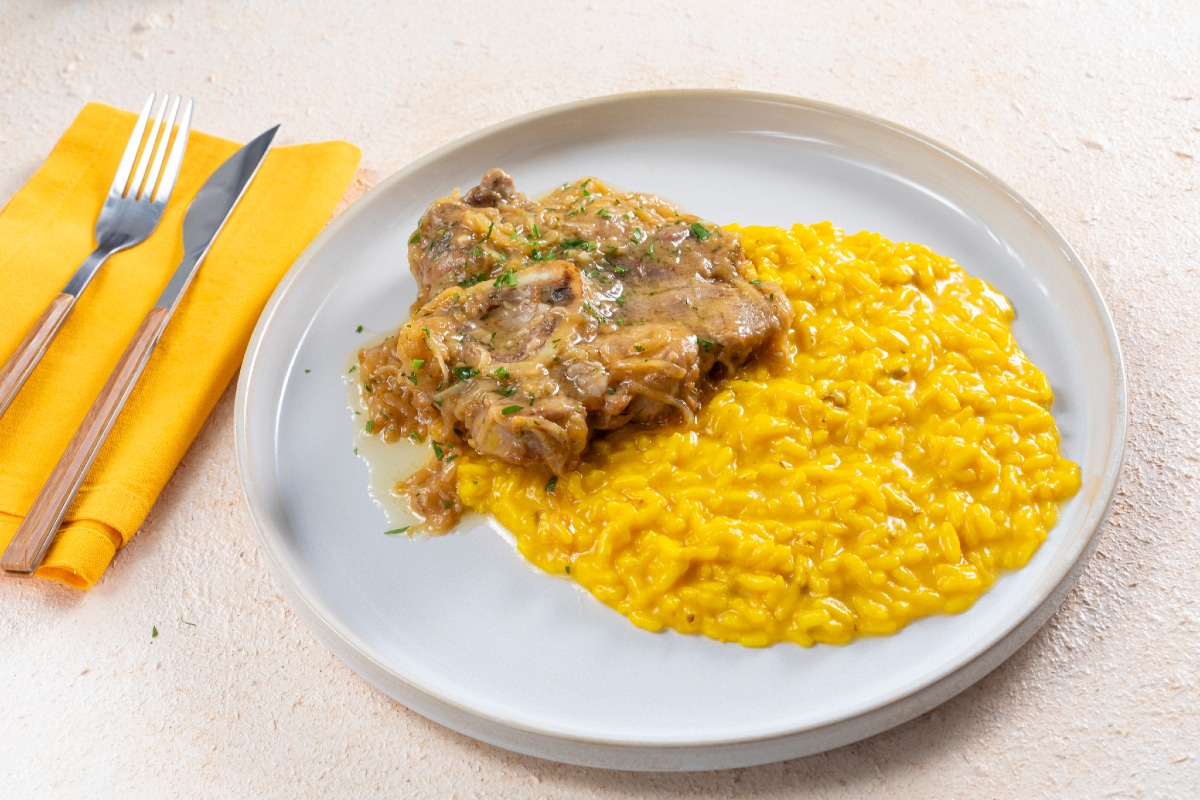Ossobuco alla Milanese with Yellow Risotto
- Average
- 4 h
- Kcal 1028

“This is a dish that should be left to the Milanese, being a specialty of Lombard cuisine. I therefore intend to describe it without any pretension, fearing to be mocked”. Thus Pellegrino Artusi introduces the recipe for Milanese ossobuco in the first cookbook in the history of Italian cuisine: a representative dish that seems to date back to the Middle Ages, characterized by a particular cut of meat made extremely tender by the long cooking and the presence of marrow, which melts and makes the preparation even more succulent. Another distinctive feature of the òs büüs a la milanesa is the addition of gremolada, a minced parsley and garlic flavored with lemon zest that completes and enhances the flavor of veal. Usually offered as a single dish together with the inevitable Risotto alla Milanese, as we propose here, the ossobuco can also be served as a tasty second meat course, perhaps accompanied by a nice portion of polenta! Moreover, you can customize the recipe by cooking, for example, ossobuco with peas or experimenting with the variation with turkey ossobuco. Like Artusi, we choose to present our version of Milanese ossobuco simply and without pretensions... let the taste speak and take you on a journey through the traditional flavors of this territory.
If you like Lombard cuisine don't miss these recipes too:

To prepare Milanese ossobuco, start with the broth: clean and coarsely chop the vegetables 1, then heat a drizzle of oil in a large pot. Add the bones 2 and toast them on both sides over medium-high heat for 3-4 minutes, then add the vegetables 3.

Sauté for another 3-4 minutes, then cover with water 4 5, cover with the lid 6 and bring to a boil. Let it simmer over low heat for about 2 hours from boiling.

Meanwhile, take care of the ossobuco: peel the onions and cut them into wedges 7. In a large pan, heat a swirl of oil, then add the onions and stew them over medium-low heat for 15-20 minutes. At this point, deglaze with half of the white wine 9 and let the alcohol evaporate completely, then slightly lower the heat and cook for another 10 minutes.

In the meantime, take the ossobuco and, using a pair of scissors, make 3 cuts on the connective tissue of each to prevent them from curling during cooking 10. When the onions are nicely golden 11, remove them from the pan 12 and set aside.

Place the flour in a baking dish and season it with salt 13 and pepper, then mix well. Dredge the ossobuco in the flour on both sides 14 and gently shake off the excess flour 15.

Pour 1/4 cup of oil into the pan where you cooked the onions, add the butter 16 and let it melt, then lay the ossobuco inside and brown over medium-high heat without touching them 17. When they are well browned on one side, turn them over 18 and brown them the same way.

Now deglaze with the remaining 2 tablespoons of wine 19 and let it evaporate. Meanwhile, the broth will be ready, so pour it into the pan until it almost covers the meat 20. Finally, add the onions 21.

Cover with the lid 22, lower the heat, and cook for 55-60 minutes, turning the ossobuco halfway through cooking. During the last 10 minutes, remove the lid to reduce the sauce. Meanwhile, prepare the gremolada: peel the garlic cloves and remove the inner germ, then boil them in boiling water for 2 minutes 23; this way the garlic flavor will be milder, but if you prefer, you can skip this step. Drain the garlic cloves and finely chop them together with the bunch of parsley 24.

While the ossobuco is cooking, take care of the risotto: in a large saucepan, put the butter 25 and the marrow 26, then stir over low heat to melt them 27.

Add the rice 28 and toast it for 3-4 minutes over medium heat, stirring often 29. When the grains are hot to the touch, deglaze with the white wine 30 and let it evaporate completely.

At this point, add a ladle of hot broth, filtering it through a sieve 31, and cook the rice, adding broth as it is absorbed; it will take about 18 minutes 32. When there are 5 minutes left until the end of the risotto's cooking time, pour the saffron into a small bowl along with a small amount of broth 33.

Mix well to dissolve it 34, then pour it into the pan with the risotto 35. Stir well 36 and finish cooking.

When the rice is cooked, turn off the heat and stir in the cold cubed butter 37 and grated Parmigiano Reggiano 38. Stir 39 and add another splash of broth, if necessary.

At this point, the ossobuco will also be ready, so turn off the heat and season with the minced parsley and garlic 40 and grated lemon zest 41. Your Milanese ossobuco is ready to be served, accompanied by the inevitable saffron risotto 42!